重新说说Redis实现分布式公平可重入锁的实现,这次具体说说异步唤醒机制,这次带上QPS检测
在之前的文章中,我们对Redisson的lock进行了刨析
如下:
- 看门狗续期
- 使用hash+lua实现可重入锁
但是还有一点,我们之前使用的自旋+线程休眠来达到线程互斥阻塞的效果。
但是这样做会有一点问题,我们每次休眠的时间都是固定的,仍然会有一大部分空窗期,我设置30s的锁过期,那么好,20个线程足足跑了两三分钟,这个效率绝对不行,对吧。
那么我们还有没有其他办法?
Redssion源码中使用了异步消息订阅
呃呃呃,之前的朋友说我的代码run不起来,没错,我故意改了一些地方,毕竟天下没有免费的午餐对吧,我主要还是提供一下思路,和大概的代码,具体的大家自行去运行了,理解会更深(bushi,好吧,我承认之前我刨析的时候自己实现的代码没有跑 ,所以今天来带大家跑一下)
那么我们也来实现一个
我们使用的是RedisTemplate,然后线程阻塞和唤醒的话我们需要一个同步锁,但是感觉有点问题
因为Java的线程阻塞和唤醒,必须要同步锁,所以我们需要一个变量,那么每个线程都要一个变量,啊啊啊,然后又要使用hashmap来存储变量对应的线程???太他妈浪费内存了
其实在JDK6之后给我提供了一个api=>LockSupport
这里面封装了一些本地方法来进行线程操作
LockSupport
简单介绍下api吧
| LockSupport.park(); //阻塞当前线程 | |
| LockSupport.parkNanos(long nanos); // 让当前线程休眠 nancos ms | |
| LockSupport.unpark(Thread thread); //唤醒指定线程 |
看到这里,我相信大家应该都有思路了。
我们实现一个FIFO队列来保证锁竞争的公平性
锁竞争公平性的保证
public static ConcurrentHashMap<String, ConcurrentLinkedQueue<Thread>> threadWaitQueue=new ConcurrentHashMap<>();;
每当锁释放的时候,我们使用消息订阅通知一下,然后unpark不就行了。
但是还有一个问题,如果说某个线程长时间占用,或者消息丢失怎么办?
所以说哦我们使用parkNanos
好了直接上源代码,这次我放能够运行的
Pub/Sub
第一个是消息监听的
| package cn.katool.lock; | |
| import cn.hutool.core.util.ObjectUtil; | |
| import cn.katool.util.ScheduledTaskUtil; | |
| import cn.katool.util.db.nosql.RedisUtils; | |
| import lombok.SneakyThrows; | |
| import lombok.extern.slf4j.Slf4j; | |
| import org.springframework.context.annotation.Bean; | |
| import org.springframework.data.redis.connection.Message; | |
| import org.springframework.data.redis.connection.MessageListener; | |
| import org.springframework.data.redis.connection.RedisConnectionFactory; | |
| import org.springframework.data.redis.listener.ChannelTopic; | |
| import org.springframework.data.redis.listener.RedisMessageListenerContainer; | |
| import org.springframework.stereotype.Component; | |
| import javax.annotation.Resource; | |
| import java.util.HashMap; | |
| import java.util.concurrent.ConcurrentHashMap; | |
| import java.util.concurrent.ConcurrentLinkedQueue; | |
| import java.util.concurrent.locks.LockSupport; | |
| public class LockMessageWatchDog implements MessageListener { | |
| public static ConcurrentHashMap<String, ConcurrentLinkedQueue<Thread>> threadWaitQueue=new ConcurrentHashMap<>();; | |
| public static final String LOCK_MQ_NAME = "LOCK:RELASE:QUEUE"; | |
| public void onMessage(Message message, byte[] pattern) { | |
| log.info("从消息通道={}监听到消息",new String(pattern)); | |
| log.info("从消息通道={}监听到消息",new String(message.getChannel())); | |
| String lockName = new String(message.getBody()).substring(1, message.getBody().length - 1); | |
| log.info("元消息={}", lockName); | |
| log.info("threadWaitQueue:{}",threadWaitQueue);; | |
| ConcurrentLinkedQueue<Thread> threads = threadWaitQueue.get(lockName); | |
| if (ObjectUtil.isEmpty(threads)||threads.isEmpty()){ | |
| log.info("没有线程需要lock:{}在等待", lockName); | |
| threadWaitQueue.remove(lockName); | |
| return ; | |
| } | |
| Thread poll = threads.poll(); | |
| log.info("唤醒线程={}",poll.getName()); | |
| LockSupport.unpark(poll); | |
| } | |
| //表示监听一个频道 | |
| public RedisMessageListenerContainer container(RedisConnectionFactory factory) { | |
| RedisMessageListenerContainer container = new RedisMessageListenerContainer(); | |
| container.setConnectionFactory(factory); | |
| container.addMessageListener(this, new ChannelTopic(LOCK_MQ_NAME)); | |
| return container; | |
| } | |
| } |
下面是锁的工具类
LockUtil
| /** | |
| * Title | |
| * | |
| * @ClassName: LockUtil | |
| * @Description:锁工具类,通过内部枚举类实现单例,防止反射攻击 | |
| * @author: Karos | |
| * @date: 2023/1/4 0:17 | |
| * @Blog: https://www.wzl1.top/ | |
| */ | |
| package cn.katool.lock; | |
| import cn.hutool.core.util.BooleanUtil; | |
| import cn.hutool.core.util.ObjectUtil; | |
| import cn.hutool.core.util.RandomUtil; | |
| import cn.katool.Config.LockConfig; | |
| import cn.katool.Exception.ErrorCode; | |
| import cn.katool.Exception.KaToolException; | |
| import cn.katool.util.ScheduledTaskUtil; | |
| import lombok.SneakyThrows; | |
| import lombok.extern.slf4j.Slf4j; | |
| import org.springframework.beans.factory.annotation.Value; | |
| import org.springframework.context.annotation.Bean; | |
| import org.springframework.context.annotation.Scope; | |
| import org.springframework.data.redis.core.RedisTemplate; | |
| import org.springframework.data.redis.core.TimeoutUtils; | |
| import org.springframework.data.redis.core.script.DefaultRedisScript; | |
| import org.springframework.stereotype.Component; | |
| import org.springframework.transaction.annotation.Transactional; | |
| import org.springframework.util.DigestUtils; | |
| import org.springframework.util.ObjectUtils; | |
| import javax.annotation.Resource; | |
| import java.util.ArrayList; | |
| import java.util.concurrent.*; | |
| import java.util.concurrent.locks.LockSupport; | |
| import static cn.katool.lock.LockMessageWatchDog.LOCK_MQ_NAME; | |
| import static cn.katool.lock.LockMessageWatchDog.threadWaitQueue; | |
| public class LockUtil { | |
| RedisTemplate redisTemplate; | |
| // lockName:uID:numbers | |
| // key[1] 锁名 | |
| // ARGV[1] UID | |
| // ARGV[2] 时间 | |
| //返回 | |
| private String lockScript; | |
| private String unLockScript; | |
| private String delayLockScript; | |
| public String serviceUUid=RandomUtil.randomString(16); | |
| private volatile static boolean isOpenCorn=false; | |
| /** | |
| * 带看门狗机制上锁 | |
| * @param lockObj | |
| * @return | |
| */ | |
| public boolean DistributedLock(Object lockObj){ | |
| try { | |
| return DistributedLock(lockObj,null,null,true); | |
| } catch (KaToolException e) { | |
| throw new RuntimeException(e); | |
| } | |
| } | |
| LockConfig lockConfig; | |
| //加锁 | |
| public Long luaToRedisByLock(String lockName,Long expTime,TimeUnit timeUnit,String[] hashkey){ | |
| long id = Thread.currentThread().getId(); | |
| //生成hashkey | |
| String hashKey=hashkey[0]= DigestUtils.md5DigestAsHex(new String(id+serviceUUid).getBytes()); | |
| log.info("serviceUUid:{},id:{},hashKey:{}",serviceUUid,id,hashKey); | |
| DefaultRedisScript defaultRedisScript = new DefaultRedisScript(); | |
| ArrayList<String> keys = new ArrayList<>(); | |
| ArrayList<Object> args = new ArrayList(); | |
| keys.add(lockName); | |
| args.add(hashKey); | |
| args.add(TimeoutUtils.toMillis(expTime,timeUnit)); | |
| defaultRedisScript.setScriptText(lockScript); | |
| defaultRedisScript.setResultType(Long.class); | |
| // log.info("lockLua -> {}",lockScript); | |
| Long execute = (Long) redisTemplate.execute(defaultRedisScript, keys, args.toArray()); | |
| if (ObjectUtil.isEmpty(execute)) { | |
| log.info("katool=> {}成功抢到锁,锁名:{},过期时间:{},单位:{}",hashKey,lockName,expTime,timeUnit); | |
| } | |
| return execute; | |
| } | |
| //释放锁 | |
| public Long luaToRedisByUnLock(String lockName,Thread thread){ | |
| long id = thread==null?Thread.currentThread().getId():thread.getId(); | |
| //生成value1 | |
| String hashKey= DigestUtils.md5DigestAsHex(new String(id+serviceUUid).getBytes()); | |
| DefaultRedisScript defaultRedisScript = new DefaultRedisScript(); | |
| ArrayList<String> keys = new ArrayList<>(); | |
| ArrayList<String> args = new ArrayList(); | |
| keys.add(lockName); | |
| args.add(hashKey); | |
| defaultRedisScript.setScriptText(unLockScript); | |
| defaultRedisScript.setResultType(Long.class); | |
| // log.info("unlockLua -> {}",unLockScript); | |
| Long remainLocks = (Long) redisTemplate.execute(defaultRedisScript, keys, args.toArray()); | |
| if (ObjectUtil.isEmpty(remainLocks)) { | |
| log.error("katool=> {}释放锁失败,请释放自己的锁,锁名:{}",hashKey,lockName); | |
| } | |
| else if(remainLocks==0){ | |
| log.info("katool=> {}成功释放锁,锁名:{}",hashKey,lockName); | |
| redisTemplate.convertAndSend(LOCK_MQ_NAME,lockName); | |
| } | |
| return remainLocks; | |
| } | |
| public Boolean luaToRedisByDelay(String lockName,Long expTimeInc,TimeUnit timeUnit){ | |
| long id = Thread.currentThread().getId(); | |
| DefaultRedisScript defaultRedisScript = new DefaultRedisScript(); | |
| ArrayList<String> keys = new ArrayList<>(); | |
| ArrayList<Object> args = new ArrayList(); | |
| keys.add(lockName); | |
| args.add(TimeoutUtils.toMillis(expTimeInc,timeUnit)+3000); | |
| defaultRedisScript.setScriptText(delayLockScript); | |
| defaultRedisScript.setResultType(Long.class); | |
| Long expire = redisTemplate.getExpire(lockName); | |
| Long execute = (Long) redisTemplate.execute(defaultRedisScript, keys, args.toArray()); | |
| return execute>expire; | |
| } | |
| /** | |
| * @param obj | |
| * @param exptime | |
| * @param timeUnit | |
| * @return | |
| * @throws KaToolException | |
| */ | |
| public boolean DistributedLock(Object obj,Long exptime,TimeUnit timeUnit,Boolean isDelay) throws KaToolException { | |
| if (ObjectUtil.isEmpty(obj)){ | |
| throw new KaToolException(ErrorCode.PARAMS_ERROR," Lock=> 传入obj为空"); | |
| } | |
| if(ObjectUtil.isEmpty(exptime)){ | |
| exptime= lockConfig.getInternalLockLeaseTime();; | |
| } | |
| if (ObjectUtils.isEmpty(timeUnit)){ | |
| timeUnit=lockConfig.getTimeUnit(); | |
| } | |
| String lockName="Lock:"+obj.toString(); | |
| Long aLong = -1L; | |
| // 进入互斥等待 | |
| Thread currentThread = Thread.currentThread(); | |
| while(true){ | |
| String[] hashkey = new String[1]; | |
| aLong=luaToRedisByLock(lockName, exptime, timeUnit, hashkey); | |
| if (aLong==null) { | |
| break; | |
| } | |
| log.debug("katool=> {}未抢到锁,线程等待通知唤醒,最多等待时间:{},锁名:{},过期时间:{},单位:{}",hashkey[0],aLong,lockName,exptime,timeUnit); | |
| // Thread.sleep(aLong/3); // 初步改进:使用线程休眠,采用自旋锁+线程互斥 | |
| ConcurrentLinkedQueue<Thread> threads = threadWaitQueue.get(lockName); | |
| if (ObjectUtil.isEmpty(threads)){ | |
| threads=new ConcurrentLinkedQueue<>(); | |
| log.info("新增线程进入等待lock:{}队列",lockName); | |
| threadWaitQueue.putIfAbsent(lockName,threads); | |
| log.debug("threadWaitQueue:{}",threadWaitQueue);; | |
| } | |
| if (!threads.contains(currentThread)) { | |
| threads.add(currentThread); | |
| } | |
| log.debug("threadWaitQueue:{}",threadWaitQueue);; | |
| LockSupport.parkNanos(aLong); // 等待通知唤醒 或者 超时自行处理 | |
| log.debug("katool=> {}未抢到锁,线程被唤醒,重新抢锁,锁名:{},过期时间:{},单位:{}",hashkey[0],lockName,exptime,timeUnit); | |
| // 线程被唤醒后删除自身的thread队列,避免死锁 | |
| if (threads.contains(currentThread)) { | |
| threads.remove(currentThread); | |
| } | |
| } | |
| //实现看门狗 | |
| if (isDelay){ | |
| Thread thread = currentThread; | |
| TimeUnit finalTimeUnit = timeUnit; | |
| Long finalExptime = exptime; | |
| ScheduledFuture<?> scheduledFuture = ScheduledTaskUtil.submitTask(new Runnable() { | |
| public void run() { | |
| boolean alive = thread.isAlive()||thread.isInterrupted(); | |
| ScheduledFuture future = threadWatchDog.get(thread.getId()); | |
| if (alive) { | |
| log.info("Thread ID:{} 线程仍然存活,看门狗续期中...", thread.getId()); | |
| delayDistributedLock(obj, finalExptime >= 3 ? (finalExptime) / 3 : finalExptime, finalTimeUnit); | |
| return; | |
| } else { | |
| if (future.isCancelled()||future.isDone()) { | |
| log.error("Thread ID:{} 线程已经死亡,但是没有对应的scheduleId", thread.getId()); | |
| return; | |
| } | |
| log.info("Thread ID:{} 线程死亡,看门狗自动解锁", thread.getId()); | |
| DistributedUnLock(obj,thread); | |
| future.cancel(true); | |
| return; | |
| } | |
| } | |
| },finalExptime, finalExptime, finalTimeUnit); | |
| threadWatchDog.put(thread.getId(),scheduledFuture); | |
| } | |
| return BooleanUtil.isTrue(aLong!=null); | |
| } | |
| ConcurrentHashMap<Long,ScheduledFuture> threadWatchDog=new ConcurrentHashMap<>(); | |
| //延期 | |
| public boolean delayDistributedLock(Object obj,Long exptime,TimeUnit timeUnit) throws KaToolException { | |
| if (ObjectUtils.isEmpty(obj)){ | |
| throw new KaToolException(ErrorCode.PARAMS_ERROR," Lock=> 传入obj为空"); | |
| } | |
| //本身就是一句话,具备原子性,没有必要使用lua脚本 | |
| Boolean expire = luaToRedisByDelay("Lock:"+obj.toString(),exptime,timeUnit); | |
| log.info("katool=> LockUntil => delayDistributedLock:{} value:{} extime:{} timeUnit:{}",obj.toString(), "1", exptime, timeUnit); | |
| return BooleanUtil.isTrue(expire); | |
| } | |
| //释放锁 | |
| public Long DistributedUnLock(Object obj) throws KaToolException { | |
| Long remainLocks = DistributedUnLock(obj, null); | |
| return remainLocks; | |
| } | |
| public Long DistributedUnLock(Object obj,Thread thread) throws KaToolException { | |
| if (ObjectUtils.isEmpty(obj)){ | |
| throw new KaToolException(ErrorCode.PARAMS_ERROR," Lock=> 传入obj为空"); | |
| } | |
| // 由于这里有了可重入锁,不应该直接删除Boolean aBoolean = redisTemplate.delete("Lock:" + obj.toString()); | |
| Long remainLocks = luaToRedisByUnLock("Lock:" + obj.toString(),thread); | |
| threadWatchDog.get(Thread.currentThread().getId()).cancel(true); | |
| threadWatchDog.remove(Thread.currentThread().getId()); | |
| log.info("katool=> LockUntil => unDistributedLock:{} isdelete:{} watchDog is cancel and drop",obj.toString(),true); | |
| return remainLocks; | |
| } | |
| //利用枚举类实现单例模式,枚举类属性为静态的 | |
| private static enum SingletonFactory{ | |
| Singleton; | |
| LockUtil lockUtil; | |
| private SingletonFactory(){ | |
| lockUtil=new LockUtil(); | |
| } | |
| public LockUtil getInstance(){ | |
| return lockUtil; | |
| } | |
| } | |
| public static LockUtil getInstance(){ | |
| return SingletonFactory.Singleton.lockUtil; | |
| } | |
| private LockUtil(){ | |
| } | |
| } |
在消息发布那里,我本来打算放在Lua脚本里面运行的,但是凡在Lua脚本里面不知道为什么执行失败,但是单独的lua,使用eval来执行又没问题,所以我放在外面,加了一层事务来运行。
其中有一个定时任务工具,在之前我是使用的HuTool的CronUtil来实现的定时任务,但是对于动态修改执行周期,不太方便,需要生成Corn表达式,所以我改成了使用ScheduledThreadPoolExecutor线程池的方式
| package cn.katool.util; | |
| import cn.hutool.cron.CronUtil; | |
| import java.sql.Time; | |
| import java.util.concurrent.*; | |
| public class ScheduledTaskUtil { | |
| private static ScheduledThreadPoolExecutor executor = new ScheduledThreadPoolExecutor(500, | |
| Executors.defaultThreadFactory(), | |
| new ThreadPoolExecutor.CallerRunsPolicy()); | |
| public static ScheduledFuture<?> submitTask(Runnable run, long delay, TimeUnit timeUnit){ | |
| ScheduledFuture<?> schedule = executor.scheduleWithFixedDelay(run, 0,delay, timeUnit); | |
| return schedule; | |
| } | |
| public static ScheduledFuture<?> submitTask(Callable run, long delay, TimeUnit timeUnit){ | |
| ScheduledFuture<?> schedule = executor.scheduleWithFixedDelay(()->{ | |
| try { | |
| run.call(); | |
| } catch (Exception e) { | |
| throw new RuntimeException(e); | |
| } | |
| }, 0,delay, timeUnit); | |
| return schedule; | |
| } | |
| public static ScheduledFuture<?> submitTask(Runnable run,long initdeay, long delay, TimeUnit timeUnit){ | |
| ScheduledFuture<?> schedule = executor.scheduleWithFixedDelay(run, initdeay,delay, timeUnit); | |
| return schedule; | |
| } | |
| public static ScheduledFuture<?> submitTask(Callable run,long initdeay, long delay, TimeUnit timeUnit){ | |
| ScheduledFuture<?> schedule = executor.scheduleWithFixedDelay(()->{ | |
| try { | |
| run.call(); | |
| } catch (Exception e) { | |
| throw new RuntimeException(e); | |
| } | |
| }, initdeay,delay, timeUnit); | |
| return schedule; | |
| } | |
| } |
测试代码
下面我们来看看试验吧,我已经将代码上传到了Maven中央仓库,大家引入依赖即可
| <dependency> | |
| <groupId>cn.katool</groupId> | |
| <artifactId>katool</artifactId> | |
| <version>1.9.0</version> | |
| </dependency> |
然后我们在yml里面进行配置
| server: | |
| port: 8081 | |
| katool: | |
| lock: | |
| internalLockLeaseTime: 30 # 分布式锁默认租约时间 | |
| timeUnit: seconds # 租约时间单位 | |
| util: | |
| redis: | |
| policy: "caffeine" # 选择内存缓存策略,caffeine | |
| exptime: {5*60*1000} # LFU过期时间 | |
| time-unit: milliseconds # 过期时间单位 | |
| spring: | |
| redis: | |
| database: 1 | |
| host: 127.0.0.1 | |
| port: 6379 | |
| timeout: 5000 | |
| lettuce: | |
| pool: | |
| max-active: 100 # 连接池最大连接数(使用负值表示没有限制) | |
| max-idle: 100 # 连接池中的最大空闲连接 | |
| min-idle: 3 # 连接池中的最小空闲连接 | |
| max-wait: -50000ms # 连接池最大阻塞等待时间(使用负值表示没有限制) | |
| task: | |
| execution: | |
| pool: | |
| core-size: 300 | |
| max-size: 700 | |
| queue-capacity: 500 | |
| keep-alive: 300s |
Controller层
| package cn.katool.katooltest; | |
| import cn.hutool.core.util.ObjectUtil; | |
| import cn.hutool.core.util.RandomUtil; | |
| import cn.katool.util.db.nosql.RedisUtils; | |
| import org.springframework.web.bind.annotation.GetMapping; | |
| import org.springframework.web.bind.annotation.RequestMapping; | |
| import org.springframework.web.bind.annotation.RestController; | |
| import javax.annotation.Resource; | |
| import java.util.concurrent.TimeUnit; | |
| public class TestController { | |
| RedisUtils redisUtils; | |
| public String test() throws InterruptedException { | |
| redisUtils.lock("this"); | |
| //synchronized ("this".intern()){ | |
| String value = (String) redisUtils.getValue("1234"); | |
| if (ObjectUtil.isEmpty(value)){ | |
| redisUtils.setValue("1234", RandomUtil.randomString(10),5L, TimeUnit.MINUTES); | |
| value = (String) redisUtils.getValue("1234"); | |
| } | |
| //} | |
| redisUtils.unlock("this"); | |
| return value.toString(); | |
| } | |
| } |
使用ApiFox进行API测试
100个线程同时并发来测试
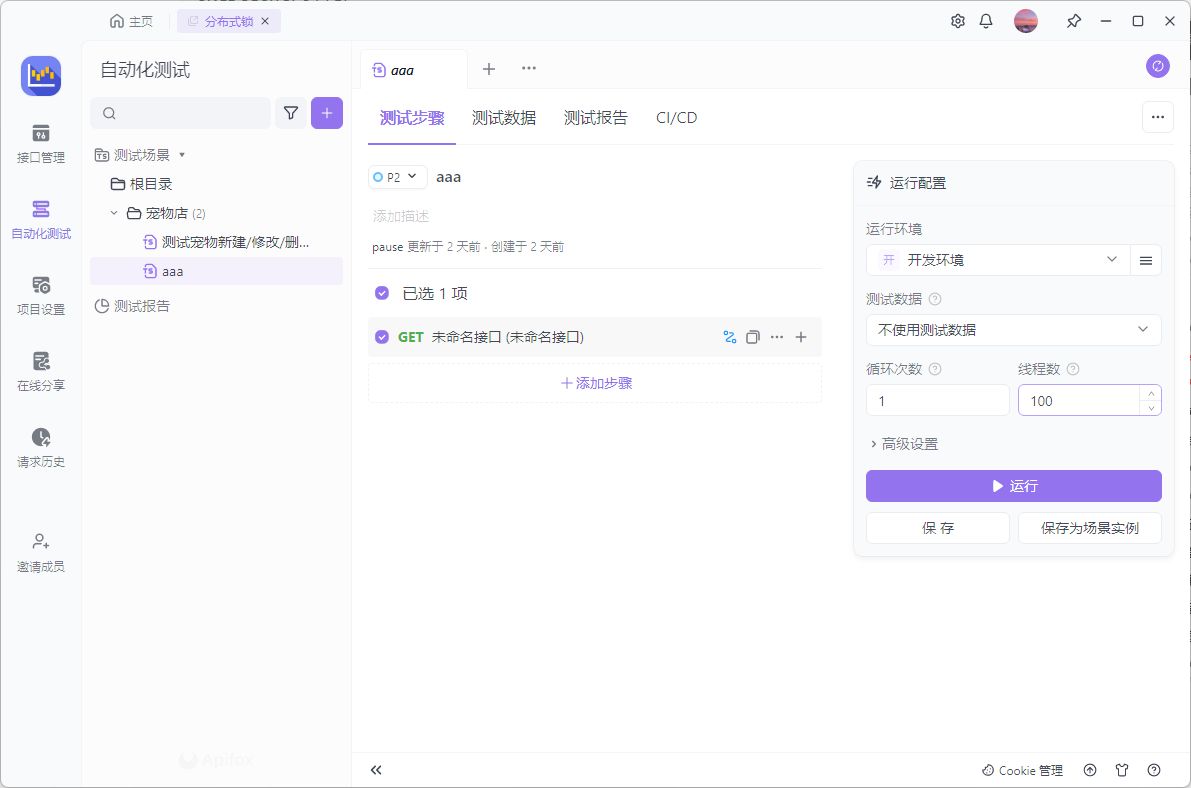
第一次测验
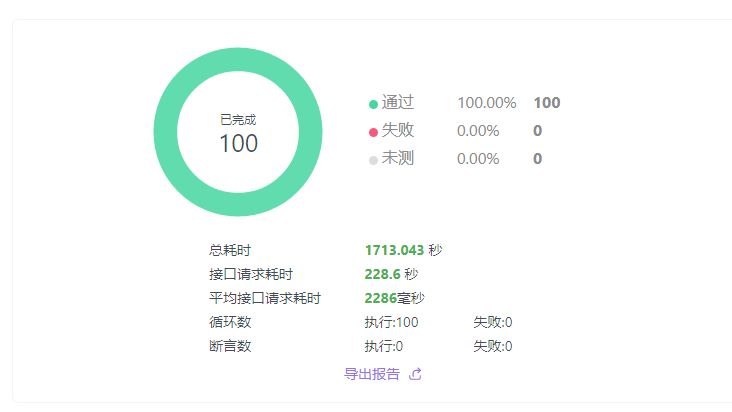
第二次测验

第三次测验
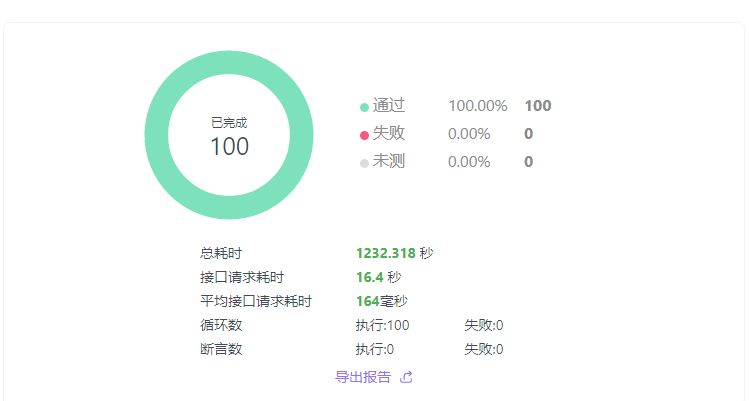
第四次测验

第五次测验

总结
出去最高和最低的,QPS的均值在1700左右
用jmetter来测试下
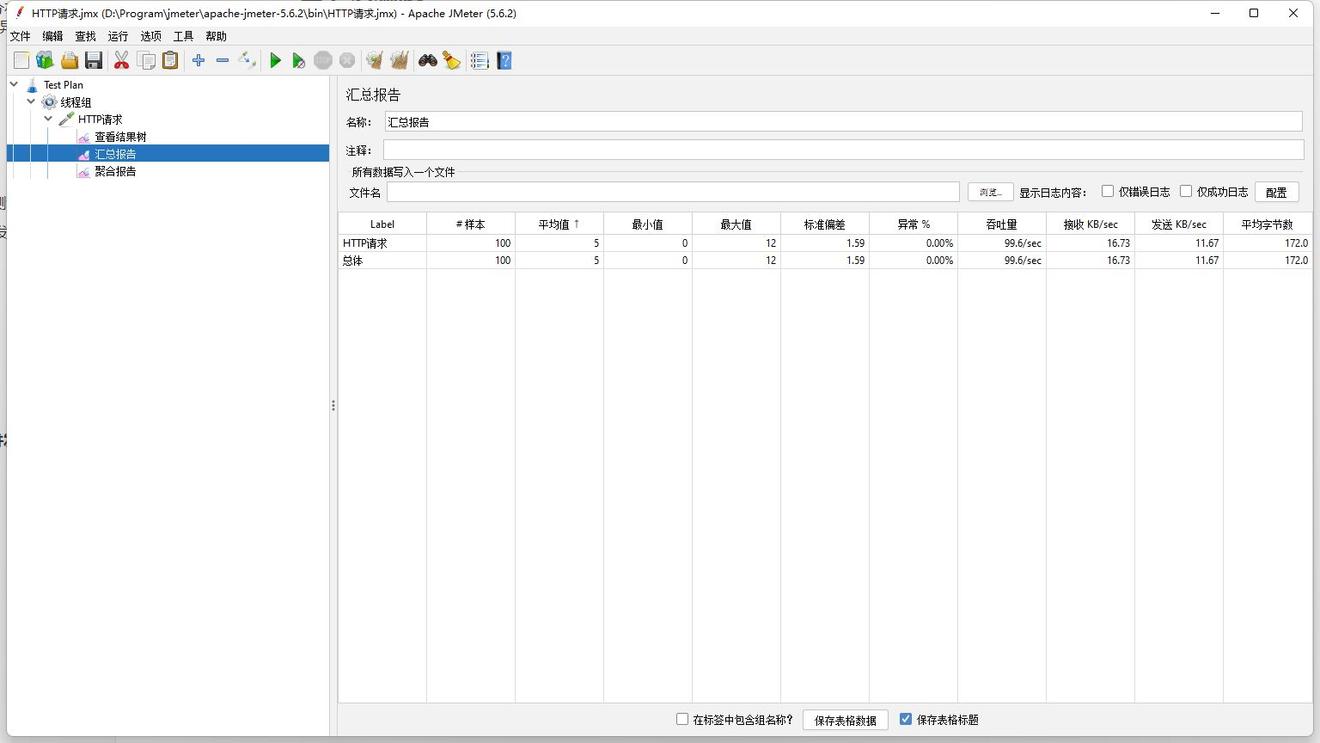
大概是1600
1000个线程同时并发测试
ApiFox,并发量上去了贼卡,还是用Jmeter吧
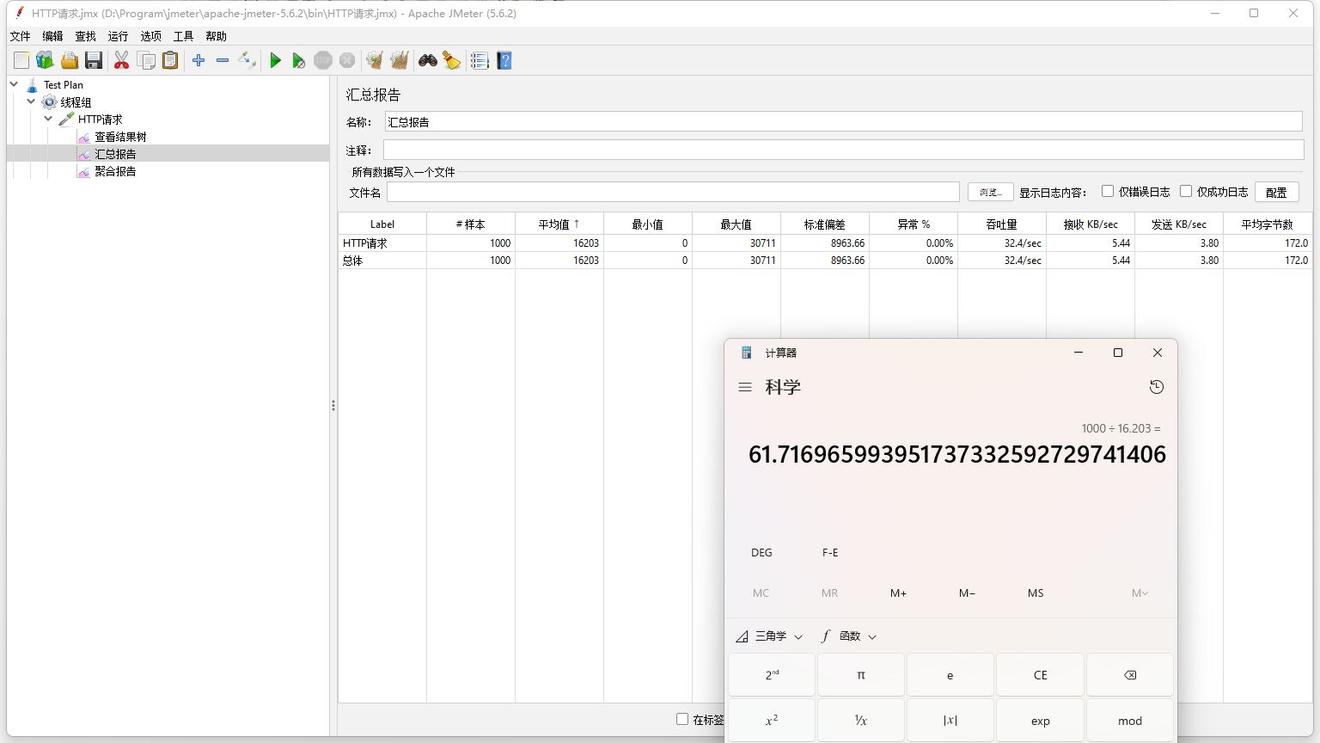
不过,这有点低啊,为了看是不是我们分布式锁的问题,我们用同步锁来试试
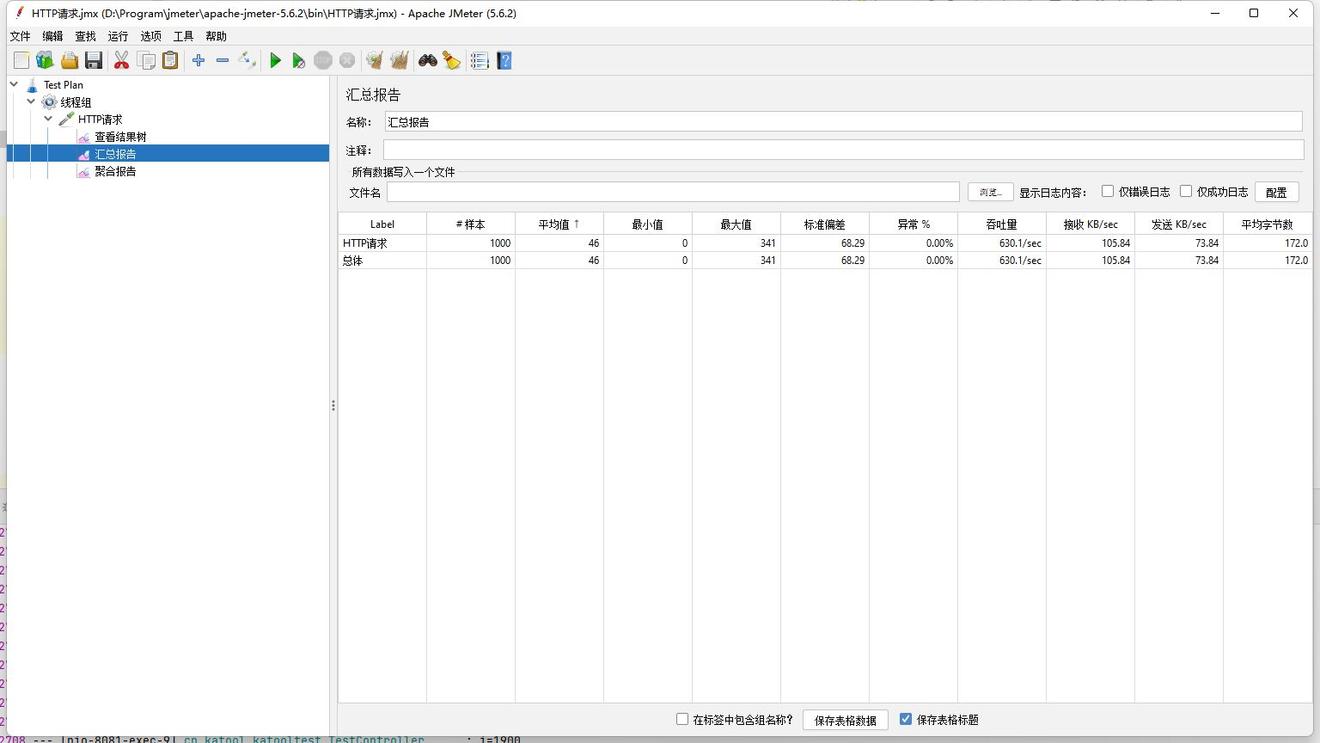
还真是
我再来试试Redisson
| package cn.katool.katooltest; | |
| import cn.hutool.core.util.ObjectUtil; | |
| import cn.hutool.core.util.RandomUtil; | |
| import cn.katool.util.db.nosql.RedisUtils; | |
| import lombok.extern.slf4j.Slf4j; | |
| import org.redisson.Redisson; | |
| import org.redisson.api.RLock; | |
| import org.springframework.web.bind.annotation.GetMapping; | |
| import org.springframework.web.bind.annotation.RequestMapping; | |
| import org.springframework.web.bind.annotation.RestController; | |
| import javax.annotation.Resource; | |
| import java.util.concurrent.TimeUnit; | |
| public class TestController { | |
| RedisUtils redisUtils; | |
| public int i=0; | |
| Redisson redisson; | |
| Integer q=100; | |
| public String test() throws InterruptedException { | |
| // redisUtils.lock("this"); | |
| RLock aThis = redisson.getLock("this"); | |
| aThis.lock(); | |
| //synchronized ("this".intern()){ | |
| String value = (String) redisUtils.getValue("1234"); | |
| log.info("i={},q={}",i++,q); | |
| if (ObjectUtil.isEmpty(value)){ | |
| redisUtils.setValue("1234", RandomUtil.randomString(10),5L, TimeUnit.MINUTES); | |
| value = (String) redisUtils.getValue("1234"); | |
| } | |
| // redisUtils.unlock("this"); | |
| aThis.unlock(); | |
| return value.toString(); | |
| //} | |
| } | |
| } |
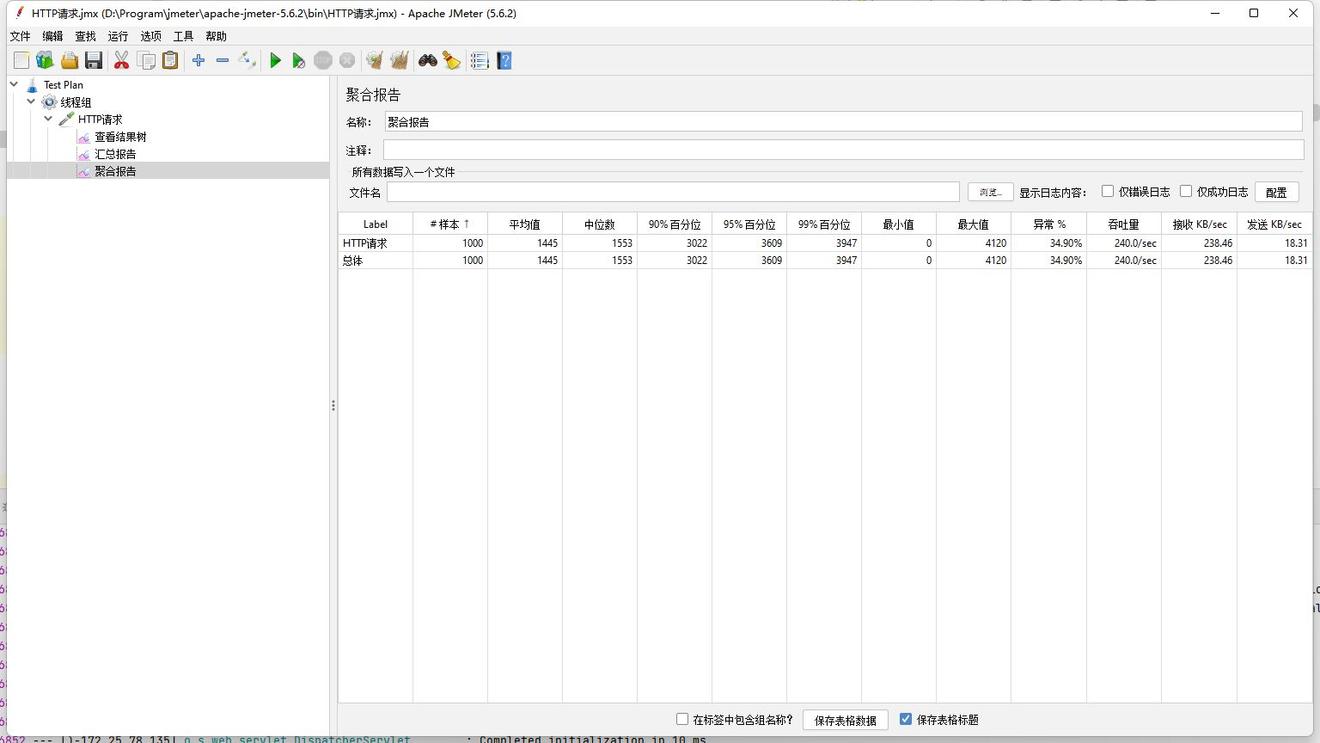
人家的QPS将近1000
好吧我是fw
会不会是因为Redisson没有使用公平锁的问题?
我们来试一试公平锁
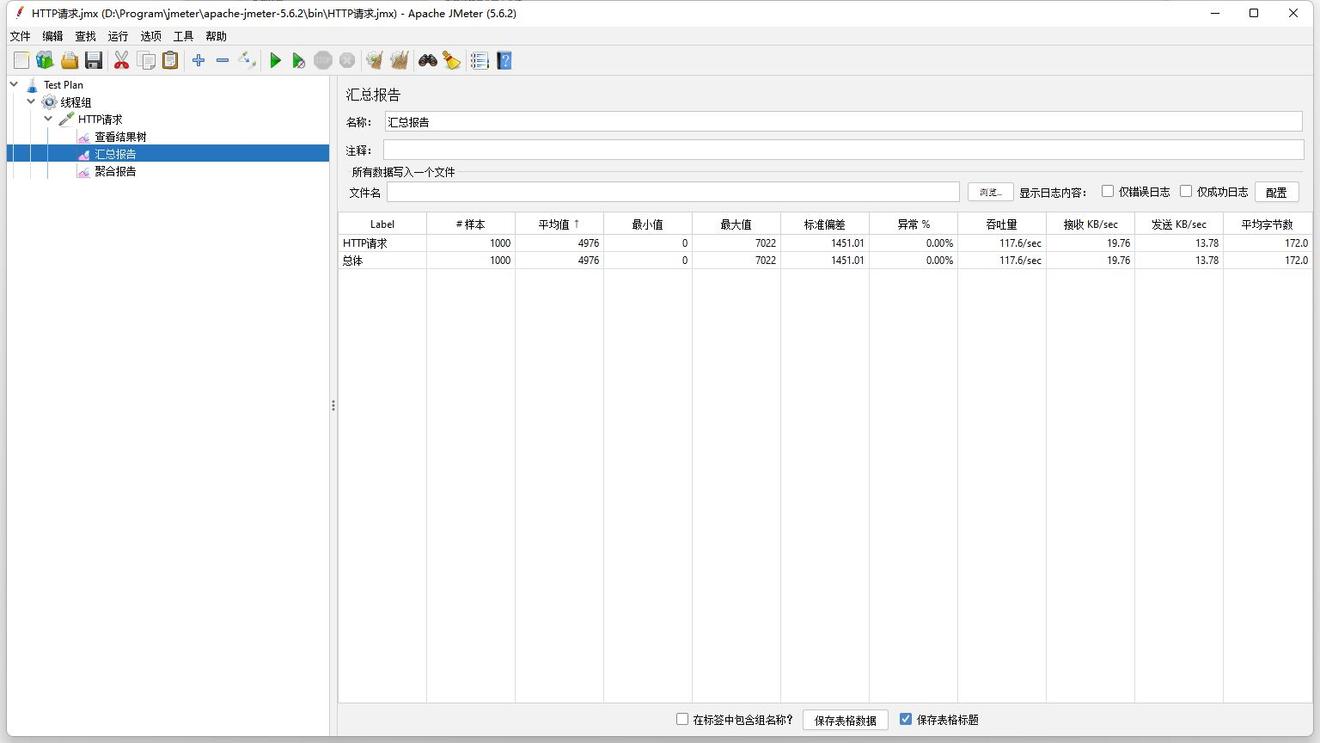
事实证明,我确实是fw
思考优化
我的思路和Redisson底层思路差不多,但是为什么会出现这么大的差错?
数据结构的选择?
我们的公平锁队列的实现方式还记得吗?
public static ConcurrentHashMap<String, ConcurrentLinkedQueue<Thread>> threadWaitQueue=new ConcurrentHashMap<>();;
我们为了并发安全使用了ConcurrentHashMap和ConcurrentLinkedQueue
使用ConcurrentHashMap是为了避免扩容时rehash,导致出现循环链表
那么我们使用ConcurrentLinkedQueue的目的呢?
我们多个线程加入的时候,是看谁先加入,Queue也是单机的
在删除的时候,如果有多个订阅者同时监听,那么可能会造成任务丢失,但是我们这里,一个服务内只有一个消费者,貌似没必要。
那么我们使用最基础的,现在改改代码
| public void onMessage(Message message, byte[] pattern) { | |
| log.info("从消息通道={}监听到消息",new String(pattern)); | |
| log.info("从消息通道={}监听到消息",new String(message.getChannel())); | |
| String lockName = new String(message.getBody()).substring(1, message.getBody().length - 1); | |
| log.info("元消息={}", lockName); | |
| log.info("threadWaitQueue:{}",threadWaitQueue);; | |
| LinkedList<Thread> threads = threadWaitQueue.get(lockName); | |
| if (ObjectUtil.isEmpty(threads)||threads.isEmpty()){ | |
| log.info("没有线程需要lock:{}在等待", lockName); | |
| threadWaitQueue.remove(lockName); | |
| return ; | |
| } | |
| Thread peek = threads.peek(); | |
| log.info("唤醒线程={}",peek.getName()); | |
| LockSupport.unpark(peek); // 竞争到后会自行删除 | |
| } | |
| LinkedList<Thread> threads = threadWaitQueue.get(lockName); | |
| while(true){ | |
| String[] hashkey = new String[1]; | |
| aLong=luaToRedisByLock(lockName, exptime, timeUnit, hashkey); | |
| if (aLong==null) { | |
| break; | |
| } | |
| log.debug("katool=> {}未抢到锁,线程等待通知唤醒,最多等待时间:{},锁名:{},过期时间:{},单位:{}",hashkey[0],aLong,lockName,exptime,timeUnit); | |
| // Thread.sleep(aLong/3); // 初步改进:使用线程休眠,采用自旋锁+线程互斥 | |
| if (ObjectUtil.isEmpty(threads)){ | |
| threads=new LinkedList<Thread>(); | |
| log.info("新增线程进入等待lock:{}队列",lockName); | |
| threadWaitQueue.putIfAbsent(lockName,threads); | |
| log.debug("threadWaitQueue:{}",threadWaitQueue);; | |
| } | |
| if (!threads.contains(currentThread)) { | |
| threads.push(currentThread); | |
| } | |
| log.debug("threadWaitQueue:{}",threadWaitQueue);; | |
| LockSupport.parkNanos(((aLong<<1)+aLong)>>1); // 自行争取一次 | |
| log.debug("katool=> {}未抢到锁,线程被唤醒,重新抢锁,锁名:{},过期时间:{},单位:{}",hashkey[0],lockName,exptime,timeUnit); | |
| } | |
| // 线程被唤醒后删除自身的thread队列,避免死锁 | |
| if (threads.contains(currentThread)) { | |
| threads.remove(currentThread); | |
| } |
看看优化后的效果?
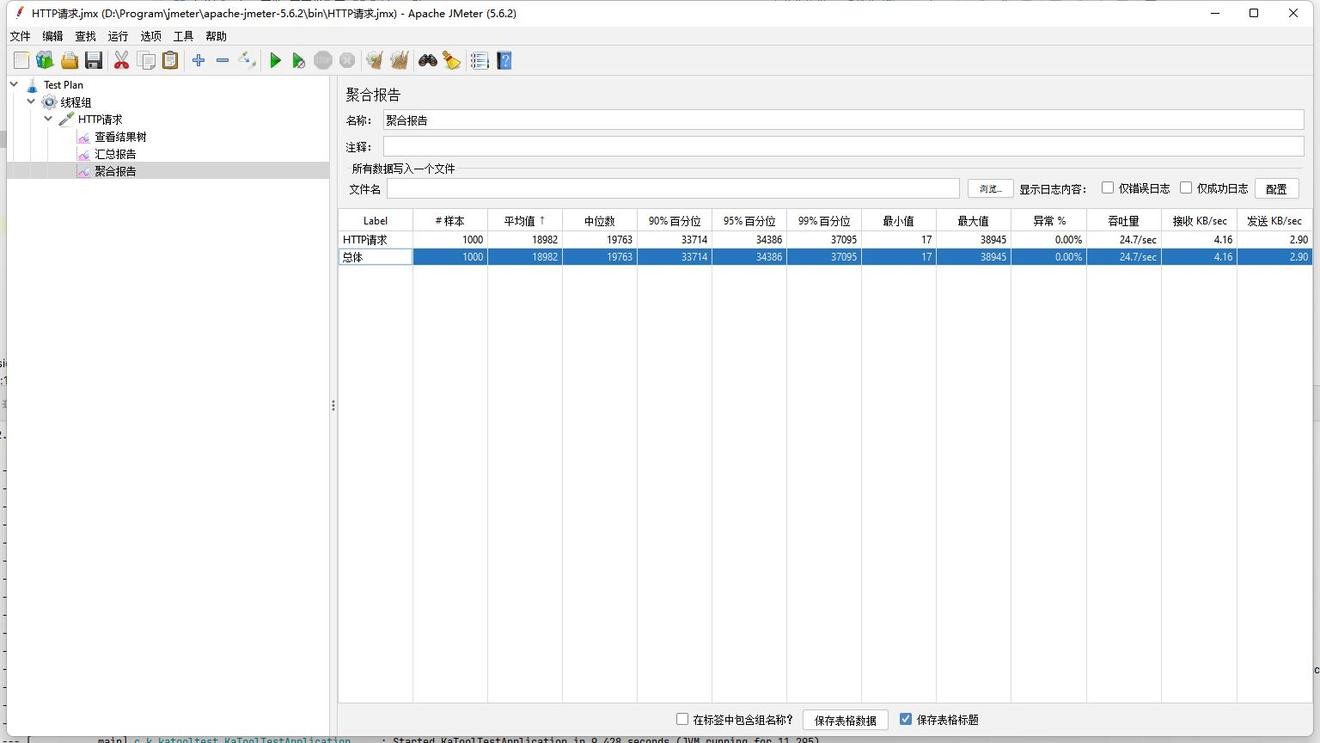
和原来差不多?难道是log的问题?
我把log改到debug级别

woc???
那我试试用线程安全的queue
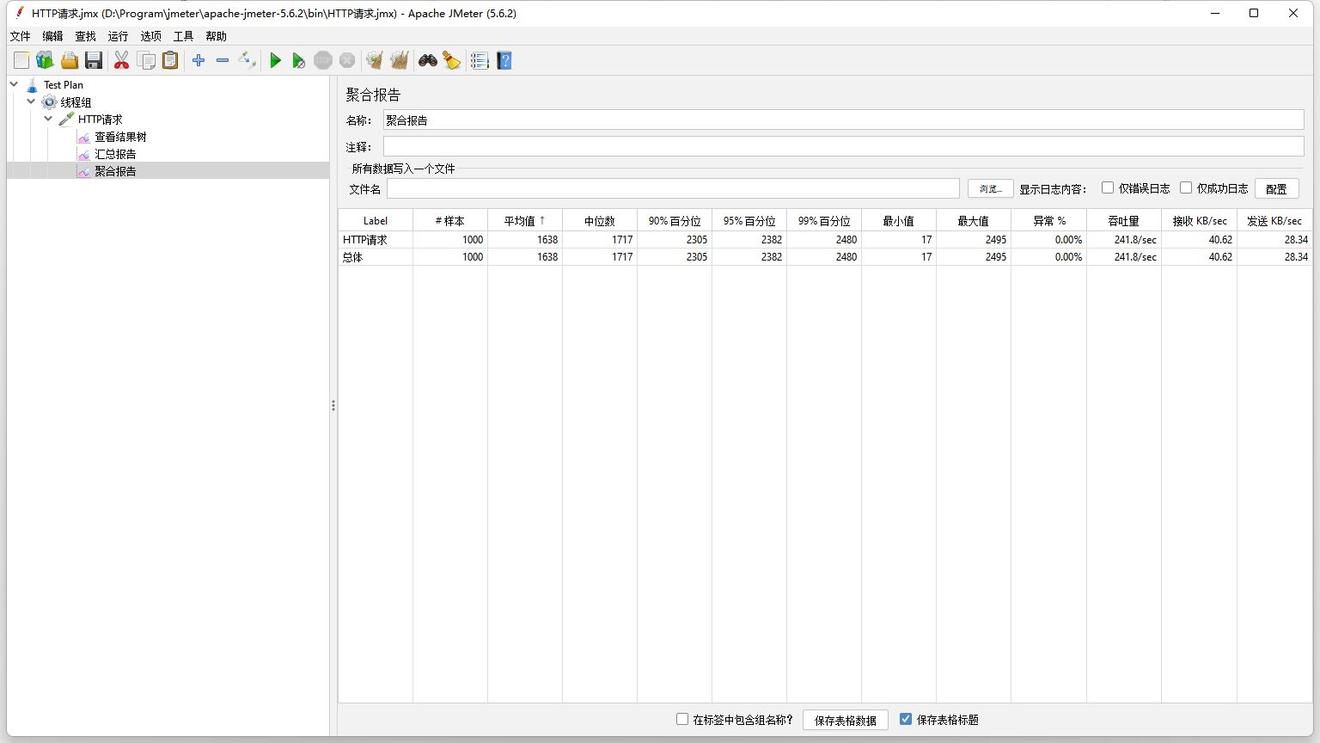
好好好,都差不多,还是改回去,免得出现一些bug,hhh
后来查了一下,log.info采用的是异步输出,也就是说会占用线程,从而大大减小了QPS,我的电脑目前单机项目最高的QPS在1k左右,最高能够并发5000个线程,超过就得报错。
3000并发测试
下面这个是3000并发的QPS
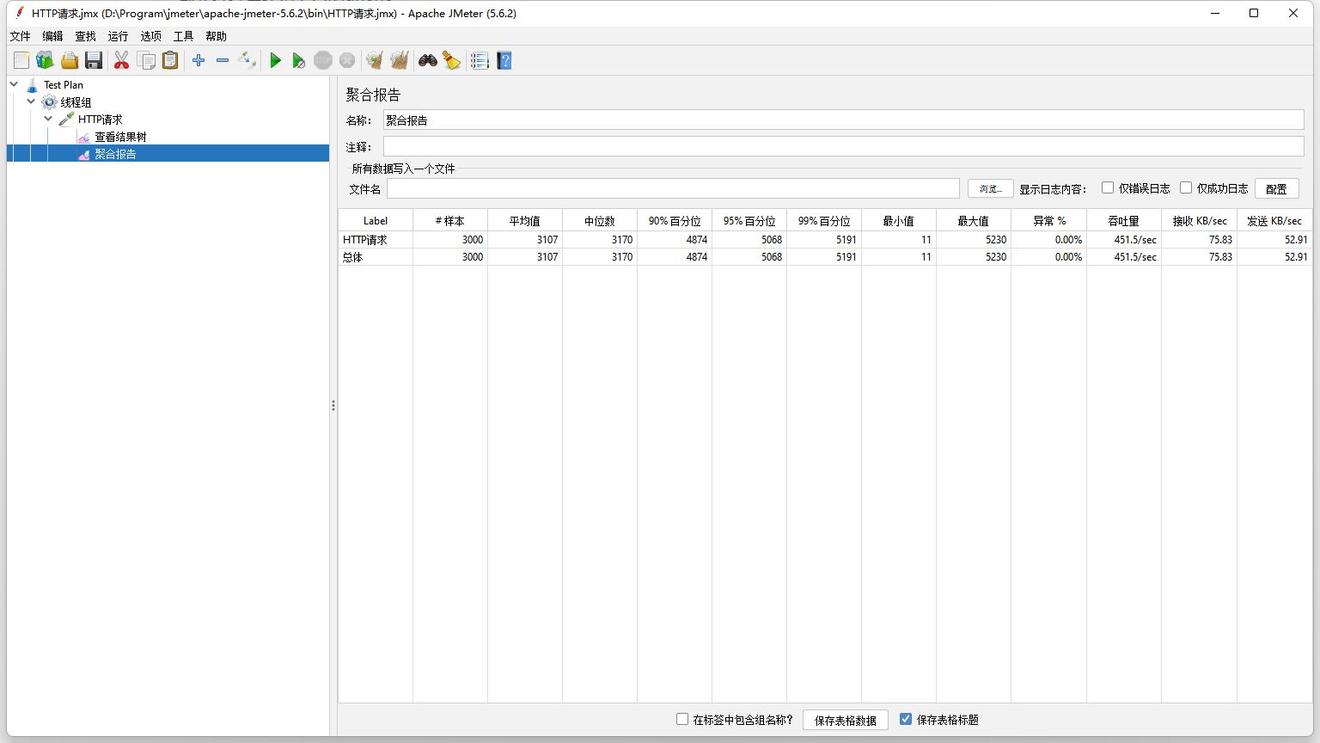
另外还有,这篇文章的代码我采用了掠夺式,也就是线程被锁一定时间后还没有被通知唤醒的话,自行回去争取一次拿锁,文章只是实现一些思路,具体的使用可以更具自己的开发环境进行修改,目前KaTool中支持掠夺和非掠夺两种方式。